Financial Accounting Report: Asset Impairment for Myer Holdings Ltd
VerifiedAdded on 2023/03/20
|10
|2576
|79
Report
AI Summary
This report examines the financial accounting issues related to asset impairment for Myer Holdings Ltd, an ASX-listed firm. Prepared for the CFO, the report addresses the requirements outlined in the assignment brief, referencing AASB 136 and a media release from ASIC. It identifies evidence necessitating impairment testing, details the processes for determining asset impairments, and evaluates management's flexibility in this process. The analysis considers the carrying value of assets, recoverable amounts, cash-generating units, and the application of relevant accounting standards. The report concludes by summarizing the company's compliance with the Australian accounting standards and the key considerations for impairment assessment, using both internal and external sources of information. The report also discusses the information required to determine asset impairment including the implications of internal and external factors such as market conditions, obsolescence, and economic environment. The report further evaluates the management flexibility in determining the asset impairment by assessing the assumptions and cash flow projections, ensuring they are reasonable and in line with market conditions.
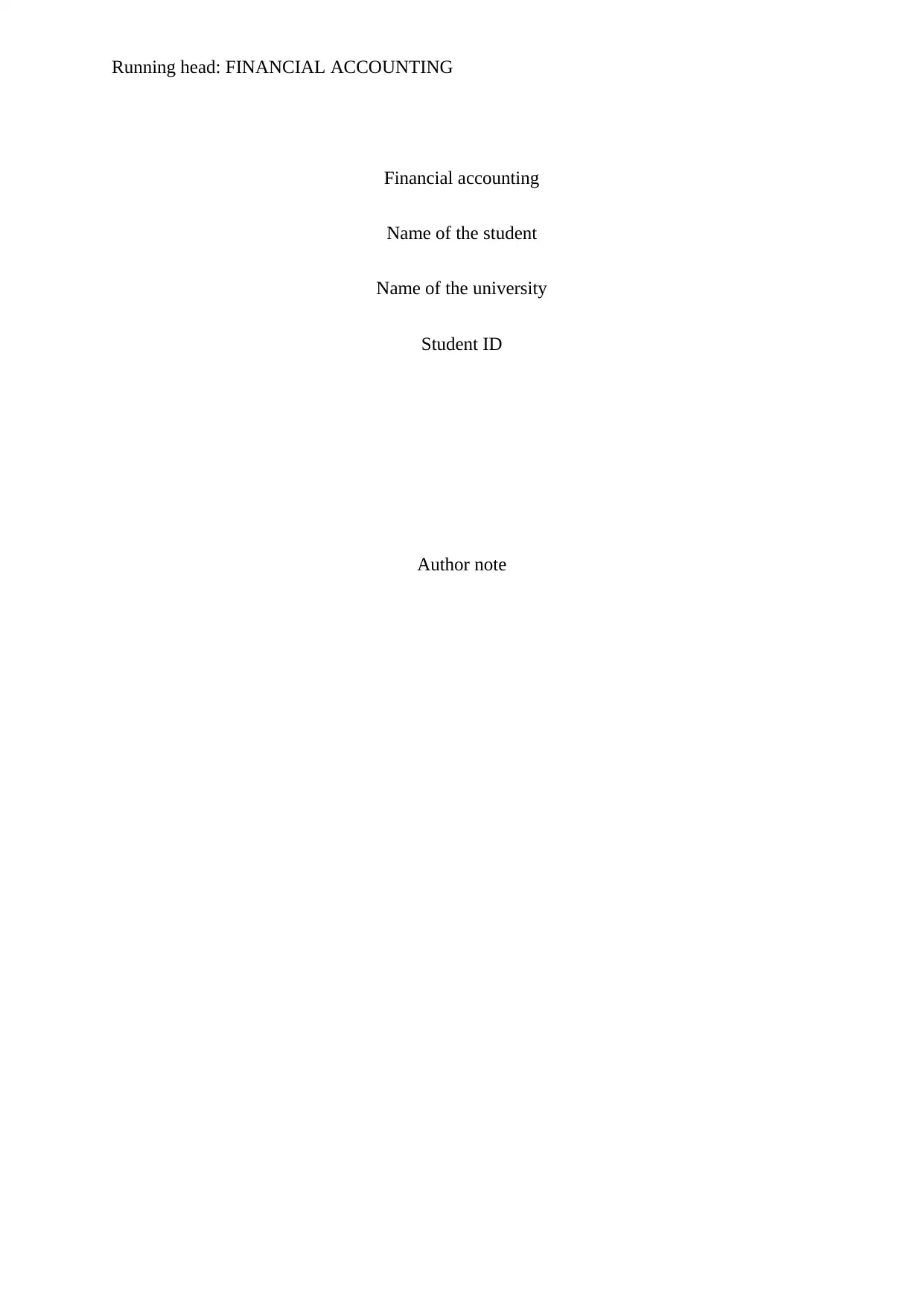
Running head: FINANCIAL ACCOUNTING
Financial accounting
Name of the student
Name of the university
Student ID
Author note
Financial accounting
Name of the student
Name of the university
Student ID
Author note
Paraphrase This Document
Need a fresh take? Get an instant paraphrase of this document with our AI Paraphraser
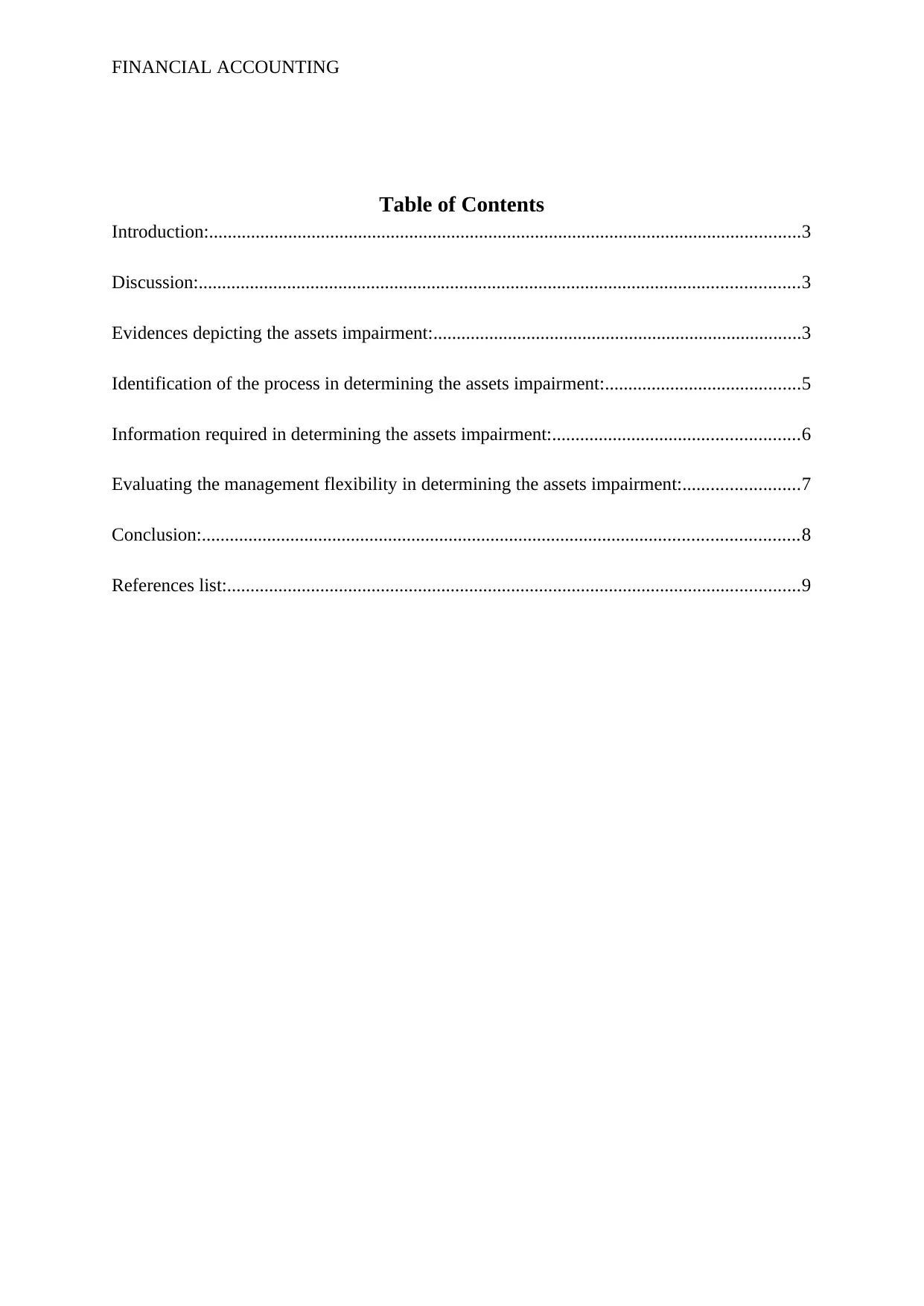
FINANCIAL ACCOUNTING
Table of Contents
Introduction:...............................................................................................................................3
Discussion:.................................................................................................................................3
Evidences depicting the assets impairment:...............................................................................3
Identification of the process in determining the assets impairment:..........................................5
Information required in determining the assets impairment:.....................................................6
Evaluating the management flexibility in determining the assets impairment:.........................7
Conclusion:................................................................................................................................8
References list:...........................................................................................................................9
Table of Contents
Introduction:...............................................................................................................................3
Discussion:.................................................................................................................................3
Evidences depicting the assets impairment:...............................................................................3
Identification of the process in determining the assets impairment:..........................................5
Information required in determining the assets impairment:.....................................................6
Evaluating the management flexibility in determining the assets impairment:.........................7
Conclusion:................................................................................................................................8
References list:...........................................................................................................................9
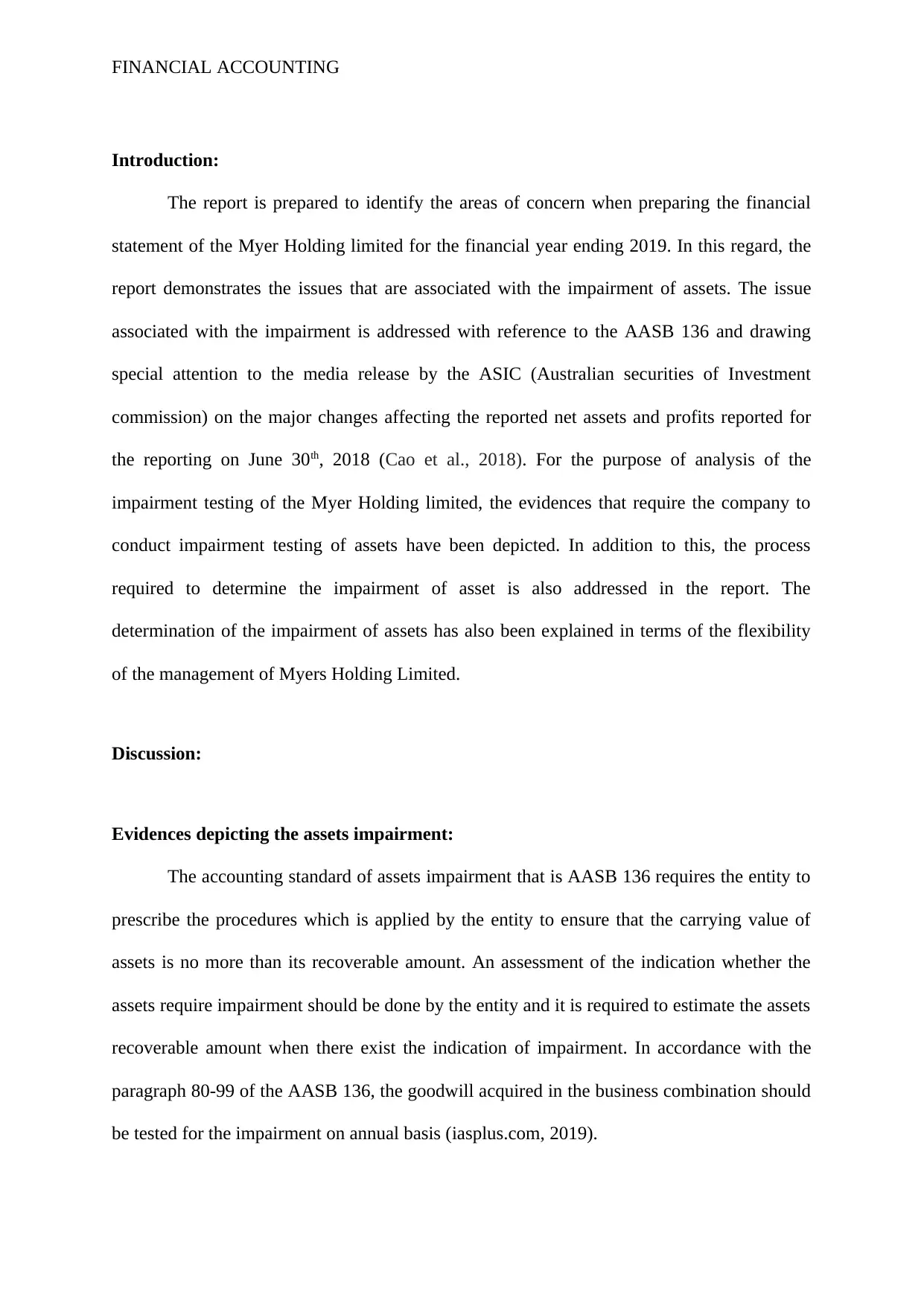
FINANCIAL ACCOUNTING
Introduction:
The report is prepared to identify the areas of concern when preparing the financial
statement of the Myer Holding limited for the financial year ending 2019. In this regard, the
report demonstrates the issues that are associated with the impairment of assets. The issue
associated with the impairment is addressed with reference to the AASB 136 and drawing
special attention to the media release by the ASIC (Australian securities of Investment
commission) on the major changes affecting the reported net assets and profits reported for
the reporting on June 30th, 2018 (Cao et al., 2018). For the purpose of analysis of the
impairment testing of the Myer Holding limited, the evidences that require the company to
conduct impairment testing of assets have been depicted. In addition to this, the process
required to determine the impairment of asset is also addressed in the report. The
determination of the impairment of assets has also been explained in terms of the flexibility
of the management of Myers Holding Limited.
Discussion:
Evidences depicting the assets impairment:
The accounting standard of assets impairment that is AASB 136 requires the entity to
prescribe the procedures which is applied by the entity to ensure that the carrying value of
assets is no more than its recoverable amount. An assessment of the indication whether the
assets require impairment should be done by the entity and it is required to estimate the assets
recoverable amount when there exist the indication of impairment. In accordance with the
paragraph 80-99 of the AASB 136, the goodwill acquired in the business combination should
be tested for the impairment on annual basis (iasplus.com, 2019).
Introduction:
The report is prepared to identify the areas of concern when preparing the financial
statement of the Myer Holding limited for the financial year ending 2019. In this regard, the
report demonstrates the issues that are associated with the impairment of assets. The issue
associated with the impairment is addressed with reference to the AASB 136 and drawing
special attention to the media release by the ASIC (Australian securities of Investment
commission) on the major changes affecting the reported net assets and profits reported for
the reporting on June 30th, 2018 (Cao et al., 2018). For the purpose of analysis of the
impairment testing of the Myer Holding limited, the evidences that require the company to
conduct impairment testing of assets have been depicted. In addition to this, the process
required to determine the impairment of asset is also addressed in the report. The
determination of the impairment of assets has also been explained in terms of the flexibility
of the management of Myers Holding Limited.
Discussion:
Evidences depicting the assets impairment:
The accounting standard of assets impairment that is AASB 136 requires the entity to
prescribe the procedures which is applied by the entity to ensure that the carrying value of
assets is no more than its recoverable amount. An assessment of the indication whether the
assets require impairment should be done by the entity and it is required to estimate the assets
recoverable amount when there exist the indication of impairment. In accordance with the
paragraph 80-99 of the AASB 136, the goodwill acquired in the business combination should
be tested for the impairment on annual basis (iasplus.com, 2019).
⊘ This is a preview!⊘
Do you want full access?
Subscribe today to unlock all pages.

Trusted by 1+ million students worldwide

FINANCIAL ACCOUNTING
Myers Holding Limited conducts an assessment annually of whether the assets require
impairment as required by the Australian accounting standard. They determine whether the
intangible assets having an indefinite useful life should be recognized or there is requirement
for impairment. As per the standard AASB 136, it is required that the carrying value of assets
should be impaired when recoverable amount is lower than the carrying value of an
intangible assets (Armstrong et al., 2017). For the purpose of impairment testing of the
intangible assets, the cash generating unit should be separated from the Myer and sass and
bide businesses.
The group for the financial year ending 2018 identified the indicators of impairment
which include the net assets of the group being higher than their market capitalization and
lower than the cash flow and expected earnings along with the competitive retail environment
in which the group carries out its operation. Consequently, the value in use discount cash
flow model is used by the group for assessing the recoverable amount of assets which
identifies that the carrying amount is more than the recoverable amount that results in
occurrence of impairment charge. A further impairment assessment is performed by the
group for each of the cash generating unit on 28th July, 2018. Such assessment involves
determination of the recoverable amount of the intangible assets based on the calculation of
value in use for each of the cash generating unit (Schatt et al., 2016). There was not further
identification of the impairment of the intangibles of Myer Holding limited.
The disclosure of information about the impairment losses and the reversal of
impairment losses for the cash generating unit and assets should be specified in accordance
with the paragraph 126-133. In addition to this, the requirements for additional disclosure
about the cash generating unit to which the allocation of intangible assets and goodwill are
done should be specified in accordance with the paragraph 134-137 of AASB 136
(iasplus.com, 2019). Recognition of the impairment loss by Myers Holding limited is done
Myers Holding Limited conducts an assessment annually of whether the assets require
impairment as required by the Australian accounting standard. They determine whether the
intangible assets having an indefinite useful life should be recognized or there is requirement
for impairment. As per the standard AASB 136, it is required that the carrying value of assets
should be impaired when recoverable amount is lower than the carrying value of an
intangible assets (Armstrong et al., 2017). For the purpose of impairment testing of the
intangible assets, the cash generating unit should be separated from the Myer and sass and
bide businesses.
The group for the financial year ending 2018 identified the indicators of impairment
which include the net assets of the group being higher than their market capitalization and
lower than the cash flow and expected earnings along with the competitive retail environment
in which the group carries out its operation. Consequently, the value in use discount cash
flow model is used by the group for assessing the recoverable amount of assets which
identifies that the carrying amount is more than the recoverable amount that results in
occurrence of impairment charge. A further impairment assessment is performed by the
group for each of the cash generating unit on 28th July, 2018. Such assessment involves
determination of the recoverable amount of the intangible assets based on the calculation of
value in use for each of the cash generating unit (Schatt et al., 2016). There was not further
identification of the impairment of the intangibles of Myer Holding limited.
The disclosure of information about the impairment losses and the reversal of
impairment losses for the cash generating unit and assets should be specified in accordance
with the paragraph 126-133. In addition to this, the requirements for additional disclosure
about the cash generating unit to which the allocation of intangible assets and goodwill are
done should be specified in accordance with the paragraph 134-137 of AASB 136
(iasplus.com, 2019). Recognition of the impairment loss by Myers Holding limited is done
Paraphrase This Document
Need a fresh take? Get an instant paraphrase of this document with our AI Paraphraser
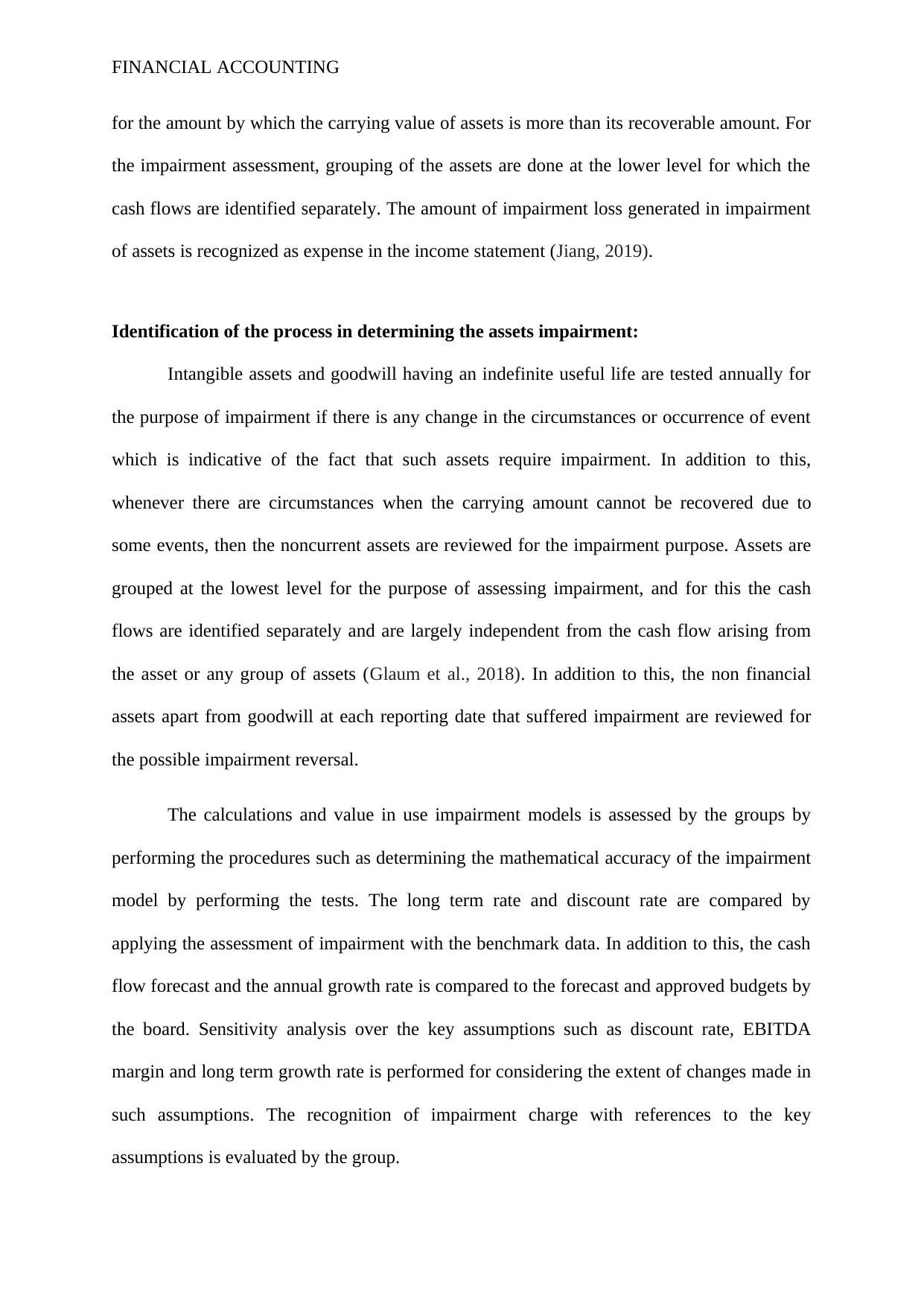
FINANCIAL ACCOUNTING
for the amount by which the carrying value of assets is more than its recoverable amount. For
the impairment assessment, grouping of the assets are done at the lower level for which the
cash flows are identified separately. The amount of impairment loss generated in impairment
of assets is recognized as expense in the income statement (Jiang, 2019).
Identification of the process in determining the assets impairment:
Intangible assets and goodwill having an indefinite useful life are tested annually for
the purpose of impairment if there is any change in the circumstances or occurrence of event
which is indicative of the fact that such assets require impairment. In addition to this,
whenever there are circumstances when the carrying amount cannot be recovered due to
some events, then the noncurrent assets are reviewed for the impairment purpose. Assets are
grouped at the lowest level for the purpose of assessing impairment, and for this the cash
flows are identified separately and are largely independent from the cash flow arising from
the asset or any group of assets (Glaum et al., 2018). In addition to this, the non financial
assets apart from goodwill at each reporting date that suffered impairment are reviewed for
the possible impairment reversal.
The calculations and value in use impairment models is assessed by the groups by
performing the procedures such as determining the mathematical accuracy of the impairment
model by performing the tests. The long term rate and discount rate are compared by
applying the assessment of impairment with the benchmark data. In addition to this, the cash
flow forecast and the annual growth rate is compared to the forecast and approved budgets by
the board. Sensitivity analysis over the key assumptions such as discount rate, EBITDA
margin and long term growth rate is performed for considering the extent of changes made in
such assumptions. The recognition of impairment charge with references to the key
assumptions is evaluated by the group.
for the amount by which the carrying value of assets is more than its recoverable amount. For
the impairment assessment, grouping of the assets are done at the lower level for which the
cash flows are identified separately. The amount of impairment loss generated in impairment
of assets is recognized as expense in the income statement (Jiang, 2019).
Identification of the process in determining the assets impairment:
Intangible assets and goodwill having an indefinite useful life are tested annually for
the purpose of impairment if there is any change in the circumstances or occurrence of event
which is indicative of the fact that such assets require impairment. In addition to this,
whenever there are circumstances when the carrying amount cannot be recovered due to
some events, then the noncurrent assets are reviewed for the impairment purpose. Assets are
grouped at the lowest level for the purpose of assessing impairment, and for this the cash
flows are identified separately and are largely independent from the cash flow arising from
the asset or any group of assets (Glaum et al., 2018). In addition to this, the non financial
assets apart from goodwill at each reporting date that suffered impairment are reviewed for
the possible impairment reversal.
The calculations and value in use impairment models is assessed by the groups by
performing the procedures such as determining the mathematical accuracy of the impairment
model by performing the tests. The long term rate and discount rate are compared by
applying the assessment of impairment with the benchmark data. In addition to this, the cash
flow forecast and the annual growth rate is compared to the forecast and approved budgets by
the board. Sensitivity analysis over the key assumptions such as discount rate, EBITDA
margin and long term growth rate is performed for considering the extent of changes made in
such assumptions. The recognition of impairment charge with references to the key
assumptions is evaluated by the group.
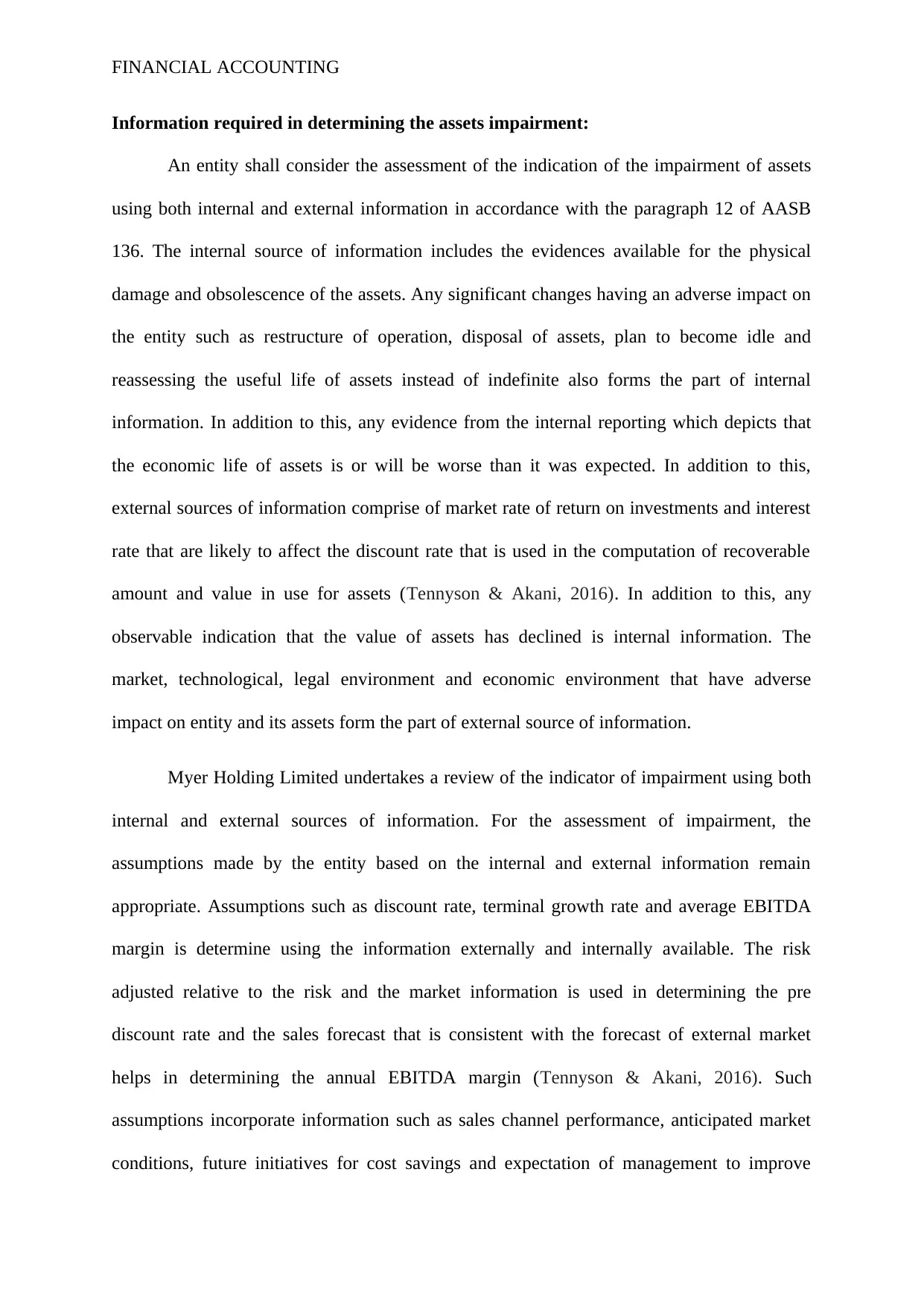
FINANCIAL ACCOUNTING
Information required in determining the assets impairment:
An entity shall consider the assessment of the indication of the impairment of assets
using both internal and external information in accordance with the paragraph 12 of AASB
136. The internal source of information includes the evidences available for the physical
damage and obsolescence of the assets. Any significant changes having an adverse impact on
the entity such as restructure of operation, disposal of assets, plan to become idle and
reassessing the useful life of assets instead of indefinite also forms the part of internal
information. In addition to this, any evidence from the internal reporting which depicts that
the economic life of assets is or will be worse than it was expected. In addition to this,
external sources of information comprise of market rate of return on investments and interest
rate that are likely to affect the discount rate that is used in the computation of recoverable
amount and value in use for assets (Tennyson & Akani, 2016). In addition to this, any
observable indication that the value of assets has declined is internal information. The
market, technological, legal environment and economic environment that have adverse
impact on entity and its assets form the part of external source of information.
Myer Holding Limited undertakes a review of the indicator of impairment using both
internal and external sources of information. For the assessment of impairment, the
assumptions made by the entity based on the internal and external information remain
appropriate. Assumptions such as discount rate, terminal growth rate and average EBITDA
margin is determine using the information externally and internally available. The risk
adjusted relative to the risk and the market information is used in determining the pre
discount rate and the sales forecast that is consistent with the forecast of external market
helps in determining the annual EBITDA margin (Tennyson & Akani, 2016). Such
assumptions incorporate information such as sales channel performance, anticipated market
conditions, future initiatives for cost savings and expectation of management to improve
Information required in determining the assets impairment:
An entity shall consider the assessment of the indication of the impairment of assets
using both internal and external information in accordance with the paragraph 12 of AASB
136. The internal source of information includes the evidences available for the physical
damage and obsolescence of the assets. Any significant changes having an adverse impact on
the entity such as restructure of operation, disposal of assets, plan to become idle and
reassessing the useful life of assets instead of indefinite also forms the part of internal
information. In addition to this, any evidence from the internal reporting which depicts that
the economic life of assets is or will be worse than it was expected. In addition to this,
external sources of information comprise of market rate of return on investments and interest
rate that are likely to affect the discount rate that is used in the computation of recoverable
amount and value in use for assets (Tennyson & Akani, 2016). In addition to this, any
observable indication that the value of assets has declined is internal information. The
market, technological, legal environment and economic environment that have adverse
impact on entity and its assets form the part of external source of information.
Myer Holding Limited undertakes a review of the indicator of impairment using both
internal and external sources of information. For the assessment of impairment, the
assumptions made by the entity based on the internal and external information remain
appropriate. Assumptions such as discount rate, terminal growth rate and average EBITDA
margin is determine using the information externally and internally available. The risk
adjusted relative to the risk and the market information is used in determining the pre
discount rate and the sales forecast that is consistent with the forecast of external market
helps in determining the annual EBITDA margin (Tennyson & Akani, 2016). Such
assumptions incorporate information such as sales channel performance, anticipated market
conditions, future initiatives for cost savings and expectation of management to improve
⊘ This is a preview!⊘
Do you want full access?
Subscribe today to unlock all pages.

Trusted by 1+ million students worldwide
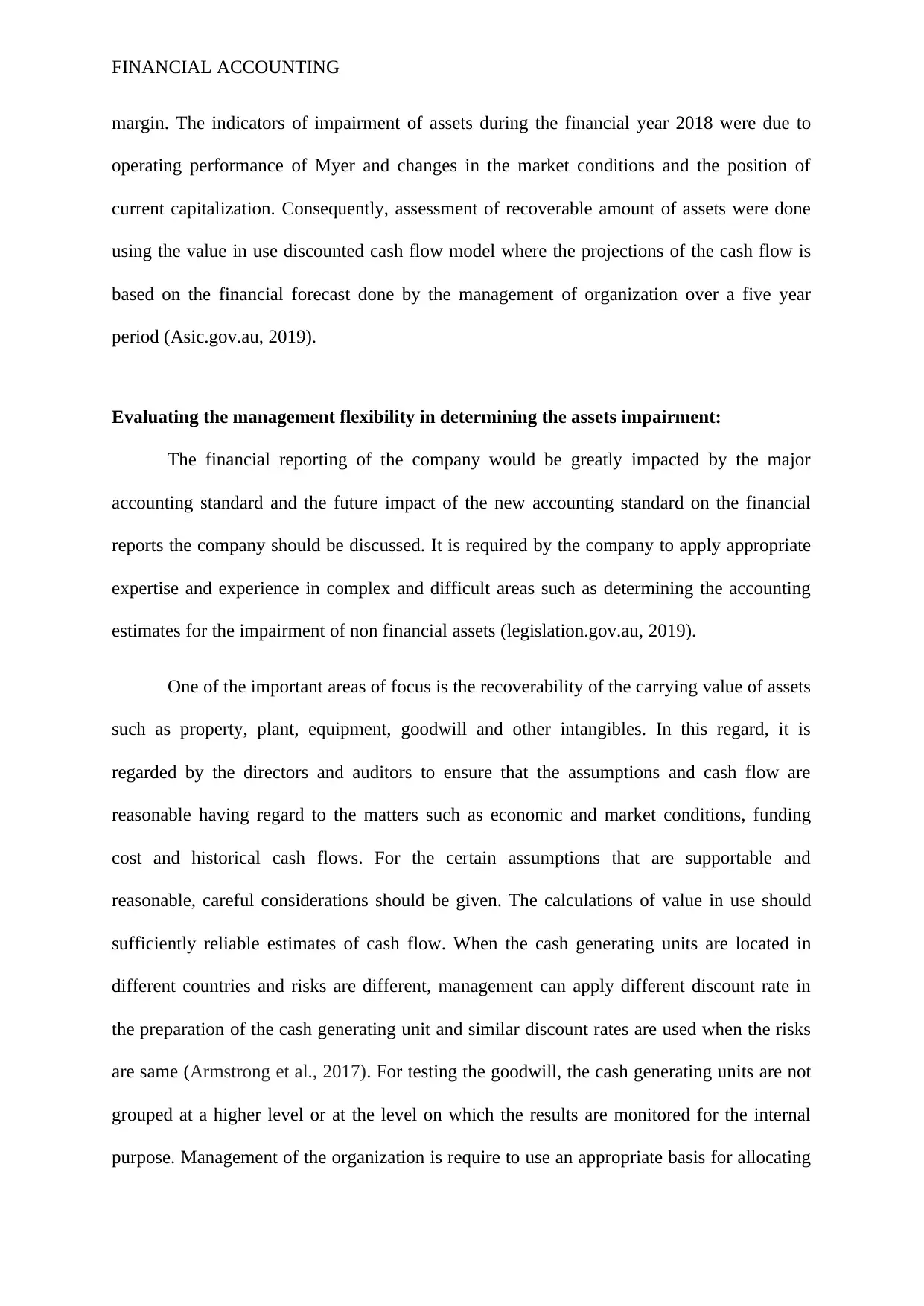
FINANCIAL ACCOUNTING
margin. The indicators of impairment of assets during the financial year 2018 were due to
operating performance of Myer and changes in the market conditions and the position of
current capitalization. Consequently, assessment of recoverable amount of assets were done
using the value in use discounted cash flow model where the projections of the cash flow is
based on the financial forecast done by the management of organization over a five year
period (Asic.gov.au, 2019).
Evaluating the management flexibility in determining the assets impairment:
The financial reporting of the company would be greatly impacted by the major
accounting standard and the future impact of the new accounting standard on the financial
reports the company should be discussed. It is required by the company to apply appropriate
expertise and experience in complex and difficult areas such as determining the accounting
estimates for the impairment of non financial assets (legislation.gov.au, 2019).
One of the important areas of focus is the recoverability of the carrying value of assets
such as property, plant, equipment, goodwill and other intangibles. In this regard, it is
regarded by the directors and auditors to ensure that the assumptions and cash flow are
reasonable having regard to the matters such as economic and market conditions, funding
cost and historical cash flows. For the certain assumptions that are supportable and
reasonable, careful considerations should be given. The calculations of value in use should
sufficiently reliable estimates of cash flow. When the cash generating units are located in
different countries and risks are different, management can apply different discount rate in
the preparation of the cash generating unit and similar discount rates are used when the risks
are same (Armstrong et al., 2017). For testing the goodwill, the cash generating units are not
grouped at a higher level or at the level on which the results are monitored for the internal
purpose. Management of the organization is require to use an appropriate basis for allocating
margin. The indicators of impairment of assets during the financial year 2018 were due to
operating performance of Myer and changes in the market conditions and the position of
current capitalization. Consequently, assessment of recoverable amount of assets were done
using the value in use discounted cash flow model where the projections of the cash flow is
based on the financial forecast done by the management of organization over a five year
period (Asic.gov.au, 2019).
Evaluating the management flexibility in determining the assets impairment:
The financial reporting of the company would be greatly impacted by the major
accounting standard and the future impact of the new accounting standard on the financial
reports the company should be discussed. It is required by the company to apply appropriate
expertise and experience in complex and difficult areas such as determining the accounting
estimates for the impairment of non financial assets (legislation.gov.au, 2019).
One of the important areas of focus is the recoverability of the carrying value of assets
such as property, plant, equipment, goodwill and other intangibles. In this regard, it is
regarded by the directors and auditors to ensure that the assumptions and cash flow are
reasonable having regard to the matters such as economic and market conditions, funding
cost and historical cash flows. For the certain assumptions that are supportable and
reasonable, careful considerations should be given. The calculations of value in use should
sufficiently reliable estimates of cash flow. When the cash generating units are located in
different countries and risks are different, management can apply different discount rate in
the preparation of the cash generating unit and similar discount rates are used when the risks
are same (Armstrong et al., 2017). For testing the goodwill, the cash generating units are not
grouped at a higher level or at the level on which the results are monitored for the internal
purpose. Management of the organization is require to use an appropriate basis for allocating
Paraphrase This Document
Need a fresh take? Get an instant paraphrase of this document with our AI Paraphraser
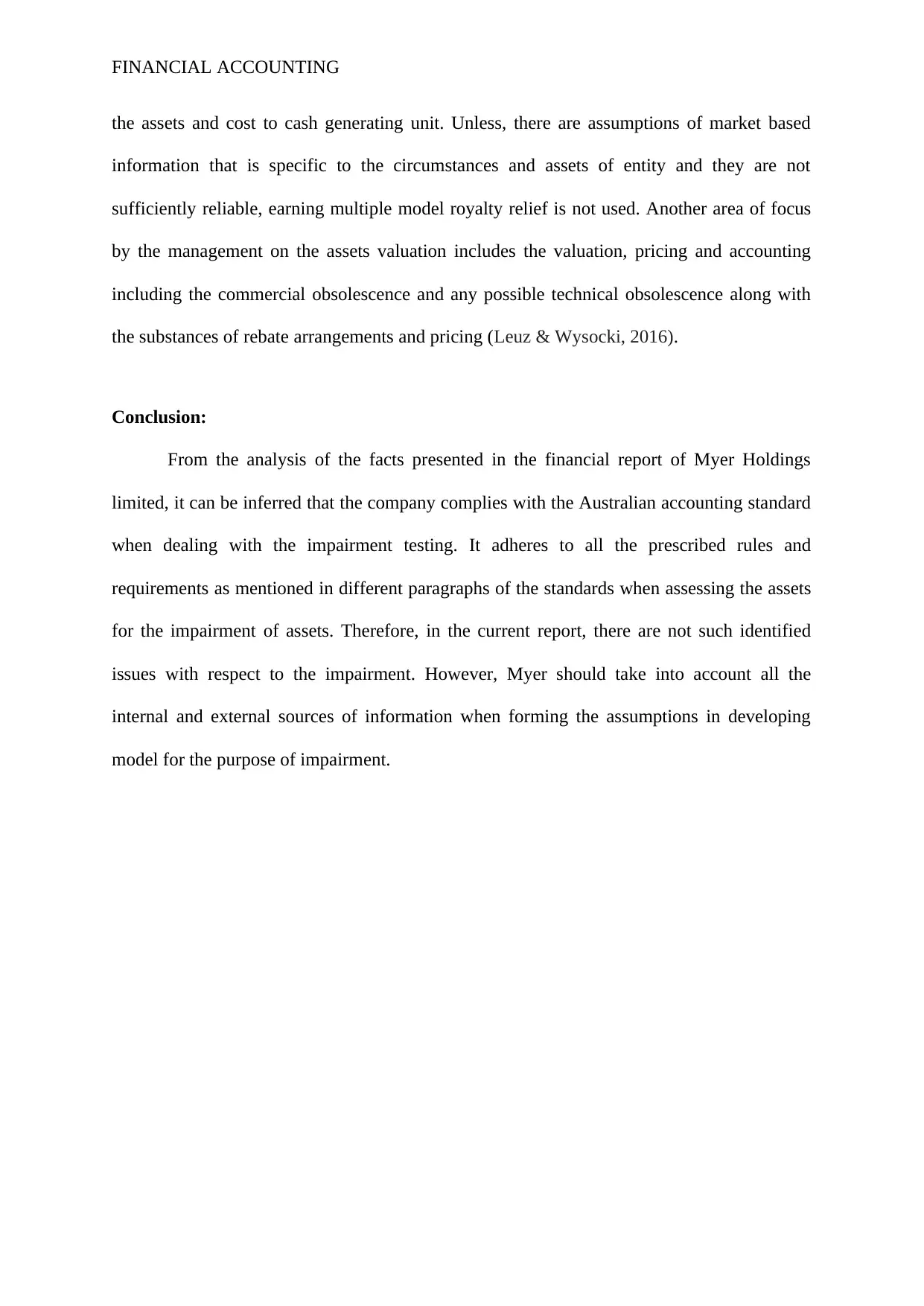
FINANCIAL ACCOUNTING
the assets and cost to cash generating unit. Unless, there are assumptions of market based
information that is specific to the circumstances and assets of entity and they are not
sufficiently reliable, earning multiple model royalty relief is not used. Another area of focus
by the management on the assets valuation includes the valuation, pricing and accounting
including the commercial obsolescence and any possible technical obsolescence along with
the substances of rebate arrangements and pricing (Leuz & Wysocki, 2016).
Conclusion:
From the analysis of the facts presented in the financial report of Myer Holdings
limited, it can be inferred that the company complies with the Australian accounting standard
when dealing with the impairment testing. It adheres to all the prescribed rules and
requirements as mentioned in different paragraphs of the standards when assessing the assets
for the impairment of assets. Therefore, in the current report, there are not such identified
issues with respect to the impairment. However, Myer should take into account all the
internal and external sources of information when forming the assumptions in developing
model for the purpose of impairment.
the assets and cost to cash generating unit. Unless, there are assumptions of market based
information that is specific to the circumstances and assets of entity and they are not
sufficiently reliable, earning multiple model royalty relief is not used. Another area of focus
by the management on the assets valuation includes the valuation, pricing and accounting
including the commercial obsolescence and any possible technical obsolescence along with
the substances of rebate arrangements and pricing (Leuz & Wysocki, 2016).
Conclusion:
From the analysis of the facts presented in the financial report of Myer Holdings
limited, it can be inferred that the company complies with the Australian accounting standard
when dealing with the impairment testing. It adheres to all the prescribed rules and
requirements as mentioned in different paragraphs of the standards when assessing the assets
for the impairment of assets. Therefore, in the current report, there are not such identified
issues with respect to the impairment. However, Myer should take into account all the
internal and external sources of information when forming the assumptions in developing
model for the purpose of impairment.
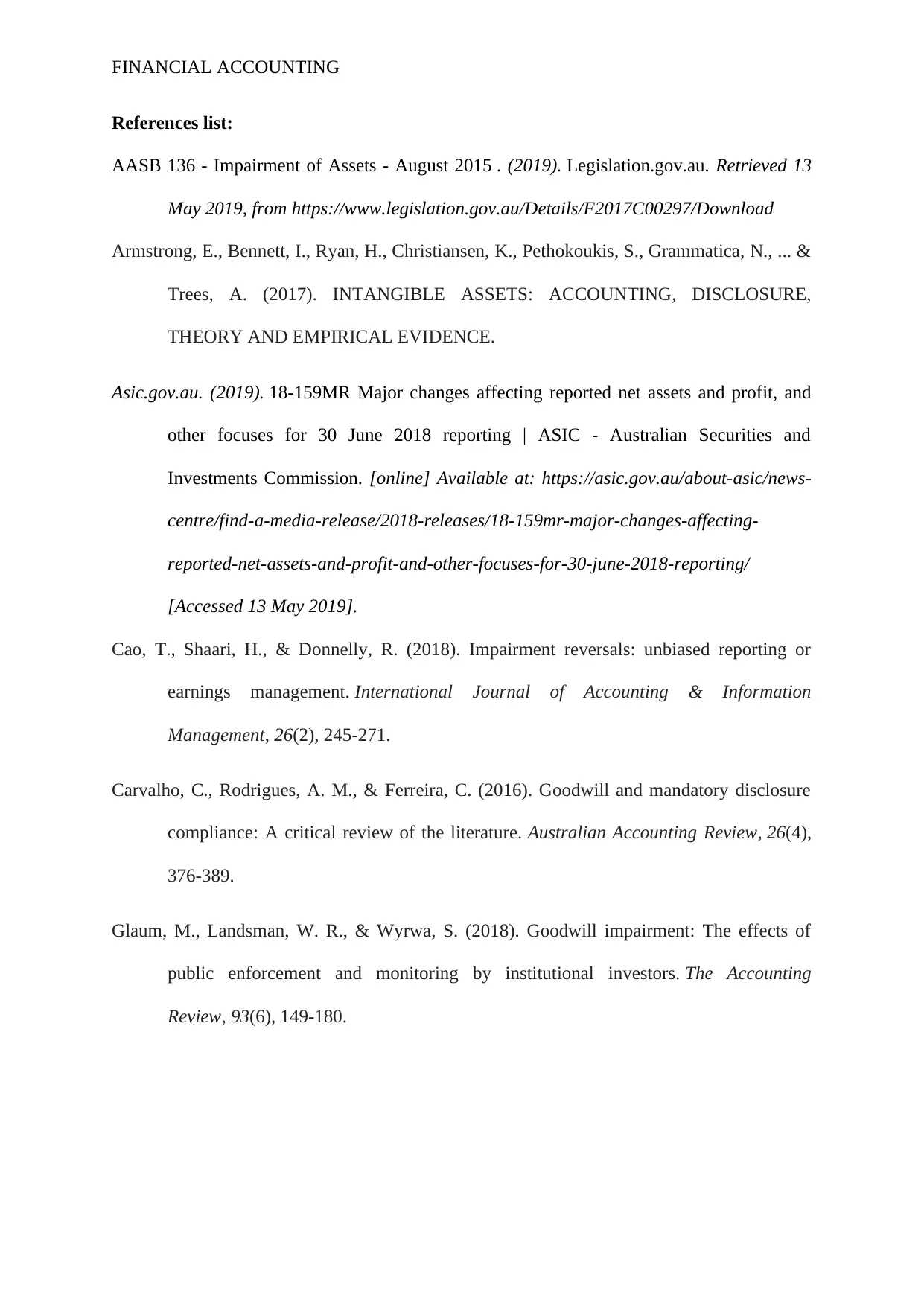
FINANCIAL ACCOUNTING
References list:
AASB 136 - Impairment of Assets - August 2015 . (2019). Legislation.gov.au. Retrieved 13
May 2019, from https://www.legislation.gov.au/Details/F2017C00297/Download
Armstrong, E., Bennett, I., Ryan, H., Christiansen, K., Pethokoukis, S., Grammatica, N., ... &
Trees, A. (2017). INTANGIBLE ASSETS: ACCOUNTING, DISCLOSURE,
THEORY AND EMPIRICAL EVIDENCE.
Asic.gov.au. (2019). 18-159MR Major changes affecting reported net assets and profit, and
other focuses for 30 June 2018 reporting | ASIC - Australian Securities and
Investments Commission. [online] Available at: https://asic.gov.au/about-asic/news-
centre/find-a-media-release/2018-releases/18-159mr-major-changes-affecting-
reported-net-assets-and-profit-and-other-focuses-for-30-june-2018-reporting/
[Accessed 13 May 2019].
Cao, T., Shaari, H., & Donnelly, R. (2018). Impairment reversals: unbiased reporting or
earnings management. International Journal of Accounting & Information
Management, 26(2), 245-271.
Carvalho, C., Rodrigues, A. M., & Ferreira, C. (2016). Goodwill and mandatory disclosure
compliance: A critical review of the literature. Australian Accounting Review, 26(4),
376-389.
Glaum, M., Landsman, W. R., & Wyrwa, S. (2018). Goodwill impairment: The effects of
public enforcement and monitoring by institutional investors. The Accounting
Review, 93(6), 149-180.
References list:
AASB 136 - Impairment of Assets - August 2015 . (2019). Legislation.gov.au. Retrieved 13
May 2019, from https://www.legislation.gov.au/Details/F2017C00297/Download
Armstrong, E., Bennett, I., Ryan, H., Christiansen, K., Pethokoukis, S., Grammatica, N., ... &
Trees, A. (2017). INTANGIBLE ASSETS: ACCOUNTING, DISCLOSURE,
THEORY AND EMPIRICAL EVIDENCE.
Asic.gov.au. (2019). 18-159MR Major changes affecting reported net assets and profit, and
other focuses for 30 June 2018 reporting | ASIC - Australian Securities and
Investments Commission. [online] Available at: https://asic.gov.au/about-asic/news-
centre/find-a-media-release/2018-releases/18-159mr-major-changes-affecting-
reported-net-assets-and-profit-and-other-focuses-for-30-june-2018-reporting/
[Accessed 13 May 2019].
Cao, T., Shaari, H., & Donnelly, R. (2018). Impairment reversals: unbiased reporting or
earnings management. International Journal of Accounting & Information
Management, 26(2), 245-271.
Carvalho, C., Rodrigues, A. M., & Ferreira, C. (2016). Goodwill and mandatory disclosure
compliance: A critical review of the literature. Australian Accounting Review, 26(4),
376-389.
Glaum, M., Landsman, W. R., & Wyrwa, S. (2018). Goodwill impairment: The effects of
public enforcement and monitoring by institutional investors. The Accounting
Review, 93(6), 149-180.
⊘ This is a preview!⊘
Do you want full access?
Subscribe today to unlock all pages.

Trusted by 1+ million students worldwide

FINANCIAL ACCOUNTING
IAS 36 — Impairment of Assets. (2019). Iasplus.com. Retrieved 13 May 2019, from
https://www.iasplus.com/en/standards/ias/ias36
Israeli, D. (2015). Recognition versus disclosure: evidence from fair value of investment
property. Review of Accounting Studies, 20(4), 1457-1503.
Jiang, Y. (2019, February). A Preliminary Study on the Management of intangible Assets in
Enterprises. In 2019 4th International Conference on Financial Innovation and
Economic Development (ICFIED 2019). Atlantis Press.
Leuz, C., & Wysocki, P. D. (2016). The economics of disclosure and financial reporting
regulation: Evidence and suggestions for future research. Journal of Accounting
Research, 54(2), 525-622.
Myer Investor Relations. (2019). Investor.myer.com.au. Retrieved 13 May 2019, from
http://investor.myer.com.au/Reports/?page=Annual-Reports
Schatt, A., Doukakis, L., Bessieux-Ollier, C., & Walliser, E. (2016). Do goodwill
impairments by European firms provide useful information to investors?. Accounting
in Europe, 13(3), 307-327.
Stein, S. E. (2018). Auditor industry specialization and accounting estimates: Evidence from
asset impairments. Auditing: A Journal of Practice and Theory.
Tennyson, O., & Akani, F. N. (2016). Assets Impairment Testing: An Analysis of IAS
36. African Research Review, 10(1), 178-192.
Vogt, M., Pletsch, C. S., Morás, V. R., & Klann, R. C. (2016). Determinants of goodwill
impairment loss recognition. Revista Contabilidade & Finanças, 27(72), 349-362.
IAS 36 — Impairment of Assets. (2019). Iasplus.com. Retrieved 13 May 2019, from
https://www.iasplus.com/en/standards/ias/ias36
Israeli, D. (2015). Recognition versus disclosure: evidence from fair value of investment
property. Review of Accounting Studies, 20(4), 1457-1503.
Jiang, Y. (2019, February). A Preliminary Study on the Management of intangible Assets in
Enterprises. In 2019 4th International Conference on Financial Innovation and
Economic Development (ICFIED 2019). Atlantis Press.
Leuz, C., & Wysocki, P. D. (2016). The economics of disclosure and financial reporting
regulation: Evidence and suggestions for future research. Journal of Accounting
Research, 54(2), 525-622.
Myer Investor Relations. (2019). Investor.myer.com.au. Retrieved 13 May 2019, from
http://investor.myer.com.au/Reports/?page=Annual-Reports
Schatt, A., Doukakis, L., Bessieux-Ollier, C., & Walliser, E. (2016). Do goodwill
impairments by European firms provide useful information to investors?. Accounting
in Europe, 13(3), 307-327.
Stein, S. E. (2018). Auditor industry specialization and accounting estimates: Evidence from
asset impairments. Auditing: A Journal of Practice and Theory.
Tennyson, O., & Akani, F. N. (2016). Assets Impairment Testing: An Analysis of IAS
36. African Research Review, 10(1), 178-192.
Vogt, M., Pletsch, C. S., Morás, V. R., & Klann, R. C. (2016). Determinants of goodwill
impairment loss recognition. Revista Contabilidade & Finanças, 27(72), 349-362.
1 out of 10
Related Documents
Your All-in-One AI-Powered Toolkit for Academic Success.
+13062052269
info@desklib.com
Available 24*7 on WhatsApp / Email
![[object Object]](/_next/static/media/star-bottom.7253800d.svg)
Unlock your academic potential
Copyright © 2020–2025 A2Z Services. All Rights Reserved. Developed and managed by ZUCOL.





